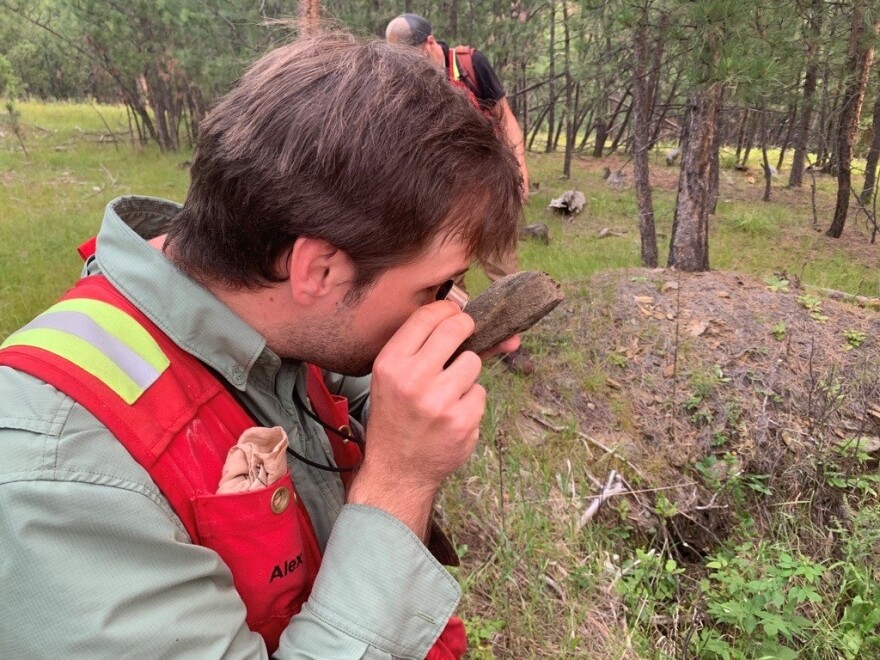The push for domestically mined critical minerals is zeroing in on the Black Hills.
While the Black Hills have historically been known to produce minerals other than gold and silver, companies are returning to map what else may exist.
Big Rock Exploration is one of the companies looking for minerals in the region. It has a contract with Midwest Lithium to map a portion of the Black Hills.
Geologist Alex Steiner recently inspected an area west of the Mt. Rushmore National Memorial for the company.

“Those are probably little pieces of quartz," Steiner said, pointing to a white rock strewn around six-foot wide crater. "So, all through the early 1900s, late 1800s, people were out here—anytime they would see that they’d put a stick of dynamite in it and blow it up and send it to one of the towns, because every town had an assayer. They would tell them if there’s gold in it or not. We find these things everywhere.”
The crater is deep enough that it shows up on a detailed LiDAR map Steiner and another geologist are color coating. They’re logging what type of rock exists where within the boundaries of a mineral claim.
To the south is the outline of Black Elk Peak. Stiener said formation is important.
“Which is a magma that crystalized underground—probably somewhere around 14 kilometers give or take—and then it shot off little dykes that look like this.”
He’s talking about the iconic, bubbly granite faces and formations the Black Hills are known for from a tourism perspective. Steiner said they’re known for something else as well.
“Some of those dykes have lithium in them, which is what we’re out here looking for. Some of them don’t. We don’t know which ones are which. So, we come out here," Steiner said. "We map them and we sample them to get an idea of what we’re looking for and where it is."
Steiner pulls out a pink color pencil to indicate pegmatites in this particular ridge.
Pegmatites exist all around the area of Mt. Rushmore and the Black Elk Wilderness. Pegmatites contain spodumene crystals—which host the element lithium.

Lithium is seen as a key mineral in the country’s transition from fossil fuels. The Biden Administration has indicated it wants those minerals mined domestically. The Inflation Reduction Act—a massive federal package passed by Democrats last year—offers incentives for that.
The first lithium mine in North America is located to the east of here, just outside of Keystone—the Etta Mine.
Mike Schlumpberger is a General Manager with Midwest Lithium. He said 50 percent of the world’s lithium is contained in spodumene crystals. Spodumene crystals look like a translucent rectangle.
Midwest Lithium recently announced its intention to drill exploration holes near Keystone and Hill City.
“The good news about it is we’re blessed with this in South Dakota," Schlumpberger said. "There aren’t many places in the world that have these materials. South Dakota has the potential to become a powerhouse for developing these lithium minerals that are so important to modern day life.”
But it’s not just Midwest Lithium that’s mapping what exists in the Black Hills.
The mountain range is seeing a significant increase in new mining claims. Latest numbers from the Bureau of Land Management show the number increased from 230 in 2019 to 4,248 in 2022. That’s an 18-fold increase.
Kwinn Neff is with South Dakota Mineral industries. He said mineral surveying is something that generally hasn’t happened here, outside of gold exploration.
“The pegmatites in the Black Hills are some of the more complex geology," Neff said. "No one has really actively—modern day—explored the pegmatites here. A lot of it was just historic—what we see, we mine. Versus today, we’re actually taking a research approach to exploring the pegmatites.”
Neff and Schlumpberger point to the role the United States can play in solving supply chain and human rights issues by producing minerals domestically.
Experts like Angela Brickey, an associate professor at South Dakota Mines, said our use of minerals changes with our technology.
“We’ve seen that with quite a few metals," Brickey said. "With platinum in the early 2000s, with lithium now, and with nickel or cobalt, we’re seeing a reduction in some commodities where we’re reducing how much we’re producing, and we’re increasing others.”
But as demand changes, one state lawmaker said the state’s current taxing structure remains in the 1800s. The state only taxes gold, silver, and energy-producing minerals like coal, oil and gas, and uranium.
The bulk of spodumene crystals are located within pegmatites. State law only requires a $100 dollar annual permit to sequester that material—similar to sand and gravel.
Rep. Kirk Chaffee hopes to change the designation. Chaffee is a retired county assessor who brought a bill to tax the mineral lithium last session. The bill failed, but the Republican from Whitewood has plans to bring a new bill next session.
“With my background in property tax, I’m looking for those area where it’s abused or unfair," Chaffee said. "Lithium comes to mind.”
As a Republican, Chaffee said he opposes new taxes. However, his background as a Director of Equalization makes him look for areas to make the state’s tax code fairer.
“I’m not trying to impose a new tax, but if we’re going to tax minerals, let’s keep it fair across the board. Let’s keep it low, let’s keep in equitable, and let’s keep it easy to administer,” Chaffee said.
As Midwest Lithium begins its exploration for lithium in the hills, Chaffee will have to convince a Republican-controlled legislature and governor the tax proposal is worthwhile.





